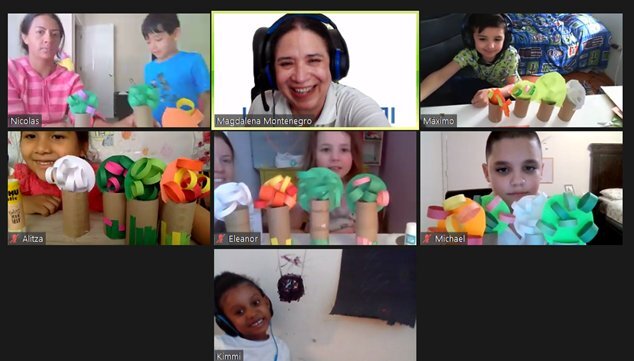
Homeschooling has emerged as a popular alternative to traditional schooling, offering flexibility, customization, and personalized education for children.
With the rise of online schools, homeschooling has become more accessible and comprehensive than ever before.
In this comprehensive guide, we will explore the concept of homeschooling and provide a step-by-step roadmap for homeschooling your child in grades K–8 with an online private school.
Whether you are considering homeschooling as a permanent solution or exploring it as a temporary alternative, this guide will equip you with the knowledge and resources to embark on this educational journey with confidence.
Ideal School has created this comprehensive guide to help you, the parent, in understanding the ins and outs of educating your child from home.
Are you ready to begin your journey?
Great…. Grab an extra large coffee or tea, we have a lot of resources for you below.
Table of Contents:
What is Homeschooling?
a. Definition and Overview
b. Legal Considerations
c. Benefits of Homeschooling
The Advantages of Online Homeschooling
a. Flexibility and Customization
b. Individualized Learning Experience
c. Enhanced Safety and Well-being
d. Access to Bilingual Education
e. Positive Socialization Opportunities
f. Seamless Integration of Technology
Selecting the Right Virtual Homeschool Program
a. Researching and Evaluating Options
b. Accreditation and Curriculum
c. Teacher Support and Student Interaction
e. Progress Tracking and Assessment
Special Education and Homeschooling
a. Homeschooling Children with Special Needs
b. Accommodations and Modifications in the Homeschool Setting
c. Resources and Support for Special Education Homeschooling
Homeschooling Multiple Children
a. Balancing Different Grade Levels and Subjects
b. Promoting Sibling Cooperation and Collaboration
c. Strategies for Efficient Time Management
Establishing a Structured Online Learning Environment
a. Creating a Dedicated Study Space
b. Setting Realistic Goals and Objectives
d. Incorporating Breaks and Extracurricular Activities
Understanding Different Learning Styles
Incorporating Real-World Learning
a. Field Trips and Educational Excursions
Planning for the Future
a. Homeschooling through High School
b. Preparing for College Admissions
c. Vocational Training and Career Exploration
Assessing and Monitoring Your Child’s Progress
a. Implementing Regular Assessments
b. Tracking Academic Growth and Development
c. Identifying Strengths and Areas for Improvement
How do I support my child’s wellbeing while in school?
a. Encouraging Regular Exercise and Outdoor Activities
b. Promoting Healthy Eating Habits
c. Establishing Routines for Adequate Sleep
d. Managing Screen Time and Digital Wellness
How Can I Get Involved And Support My Child’s Education?
a. Balancing Parenting and Teaching Roles
b. Providing Emotional Support and Encouragement
c. Building Strong Relationships with Teachers and Staff
d. Seeking Professional Development Opportunities
Overcoming Homeschooling Challenges and Finding Solutions
a. Addressing Isolation and Loneliness
b. Managing Technical Issues and Connectivity
c. Fostering Motivation and Engagement
d. Adapting to Changing Circumstances
Transitioning to and from Traditional Schooling
a. Preparing for the Transition
b. Assisting with Reintegration into Traditional Schools
c. Handling Emotional Adjustments
What is Homeschooling?
Homeschooling is an educational approach in which parents take on the role of primary educators, providing instruction and guidance to their children at home. It involves designing a personalized curriculum tailored to the child’s individual needs and learning style.
Homeschooling offers a flexible and adaptable learning environment, allowing for a customized education that goes beyond the limitations of traditional classroom settings. However, it’s essential to understand the legal considerations surrounding homeschooling.
Laws and regulations regarding homeschooling vary by country and even within different regions. Familiarizing yourself with the legal requirements and obligations is crucial to ensuring compliance and protecting your child’s educational rights.
Despite these considerations, home education presents numerous benefits. It allows for a more individualized learning experience, tailored to the child’s strengths, interests, and pace of learning.
Homeschooled children often have increased opportunities for experiential learning, personalized attention, and the ability to explore subjects beyond the confines of a standard curriculum.
Additionally, homeschooling fosters closer family bonds, promotes independent thinking, and offers a safe and nurturing learning environment.
The Advantages of Online Homeschooling
Flexibility and Customization
Online homeschooling offers unparalleled flexibility, allowing families to tailor the educational experience to their unique needs.
Parents can create personalized schedules, adapt the curriculum to suit their child’s learning style, and adjust the pace of instruction.
This flexibility enables students to explore their interests, delve deeper into subjects they are passionate about, and even pursue extracurricular activities without the constraints of a traditional school schedule.
Individualized Learning Experience
With online homeschooling, each child receives individualized attention and instruction. Parents can identify their child’s strengths and weaknesses and create personalized lesson plans to cater to their specific learning needs.
This approach fosters a deeper understanding of concepts, encourages critical thinking, and promotes academic growth at a pace that is comfortable for the student.
Enhanced Safety and Well-Being
Online homeschooling provides a safe and secure learning environment, which is particularly important in today’s world.
Students are shielded from potential safety concerns present in physical school settings.
Additionally, online learning allows families to prioritize the overall well-being of their children, ensuring a healthy balance between academics, physical activity, and emotional development.
Access to Bilingual Education
Online homeschooling programs often offer bilingual education options, allowing children to develop fluency in multiple languages from an early age.
This exposure to different languages and cultures provides a significant advantage in our increasingly interconnected global society, opening doors to future opportunities and fostering cultural understanding and appreciation.

Positive Socialization Opportunities
Contrary to common misconceptions, online homeschooling provides ample opportunities for socialization.
Virtual homeschooling communities, co-ops, and local meetups enable students to interact with peers and participate in group activities, field trips, and discussions. These experiences foster social skills, collaboration, and the formation of meaningful friendships.

Seamless Integration of Technology
Online homeschooling seamlessly integrates technology into the learning process. Students have access to a wide array of educational resources, multimedia content, and interactive tools that enhance engagement and understanding.
Digital platforms enable immediate feedback, interactive discussions, and collaboration with teachers and fellow students, creating a dynamic and stimulating learning environment.
In summary, online homeschooling offers numerous advantages, including flexibility, customization, individualized learning, enhanced safety, access to bilingual education, positive socialization, and seamless integration of technology.
Embracing this educational approach empowers families to provide a high-quality and well-rounded education for their children, tailored to their unique needs and interests.
Selecting the Right Virtual Homeschool Program
Researching and Evaluating Options
When choosing a virtual homeschool program, thorough research is essential. Explore different program options, read reviews, and gather information about their curriculum, teaching methods, and overall reputation. Consider the program’s approach to online learning and ensure it aligns with your goals and expectations for your child’s language development.
Online Learning Accreditation and Curriculum
It’s crucial to select a virtual homeschool program that is accredited and meets educational standards.
Look for programs that adhere to recognized accreditation bodies and follow a comprehensive and well-rounded curriculum. Evaluate the curriculum to ensure it offers a balanced blend of academic subjects, language learning, cultural studies, and enrichment activities.
Teacher Support and Student Interaction
Assess the level of teacher support and student interaction offered by the virtual homeschool program.
Look for programs that provide qualified and experienced teachers who are readily available to answer questions, provide guidance, and offer feedback. Additionally, consider the opportunities for students to interact with peers through virtual classrooms, discussion forums, and collaborative projects.
Resources and Tools
A robust virtual bilingual homeschool program should offer a wide range of resources and tools to support learning. Investigate the program’s technological infrastructure, learning management systems, and accessibility to digital resources.
Ensure that the program provides a variety of multimedia content, interactive activities, and supplementary materials that enhance the learning experience.
Progress Tracking and Assessment
Effective progress tracking and assessment are crucial for monitoring your child’s academic development. Inquire about the virtual homeschool program’s methods of assessment and progress tracking.
Look for programs that provide regular feedback on your child’s performance, offer detailed progress reports, and facilitate parent-teacher communication. A well-structured assessment system will help you identify areas of strength and areas that require additional support or attention.
By carefully considering these factors when selecting a virtual bilingual homeschool program, you can ensure that you choose a program that aligns with your educational goals, provides adequate support, engages your child in meaningful learning experiences, and allows for effective progress tracking and assessment.
A comprehensive and well-designed program will lay the foundation for a successful bilingual homeschooling journey for your child.
Special Education and Homeschooling
Homeschooling Children with Special Needs:
Homeschooling can be an excellent option for children with special needs, as it allows for a customized and individualized approach to their education. When homeschooling children with special needs, it’s important to understand their unique learning requirements, strengths, and challenges.
Tailor your homeschooling curriculum to accommodate their specific needs, providing a supportive and nurturing environment that promotes their academic and personal growth.
Homeschooling allows you to work at your child’s pace, offer one-on-one instruction, and implement specialized strategies to address their individual learning styles.
Accommodations and Modifications in the Homeschool Setting:
In a homeschool setting, you have the flexibility to provide accommodations and modifications to meet your child’s special education needs effectively.
Modify instructional materials, adapt teaching methods, and provide assistive technology or sensory tools as necessary.
Create a learning environment that promotes accessibility, promotes sensory regulation, and addresses any specific learning challenges your child may have.
Individualize assessments to measure their progress accurately and adjust instructional strategies accordingly.
Resources and Support for Special Education Homeschooling:
Homeschooling children with special needs requires access to appropriate resources and support.
Utilize online resources, educational materials, and specialized curricula designed for special education homeschooling.
Connect with local support groups or online communities of homeschooling parents with special needs children to share experiences, seek advice, and access valuable resources.
We have an immense amount of resources at your fingertips. You can contact us at anytime during the course of your child’s online education.
Homeschooling Multiple Children

Balancing Different Grade Levels and Subjects
Homeschooling multiple children of different grade levels and subjects can seem challenging, but with proper planning and organization, it can be manageable. Create a schedule that allows for individualized instruction and group activities.
Utilize curriculum resources that accommodate multiple grade levels, such as multi-level textbooks or online programs. Set realistic expectations for each child, considering their developmental stage and academic abilities. Implement a rotating schedule or block scheduling system to dedicate focused time to each child’s specific needs and subjects.
Promote Sibling Cooperation and Collaboration
Encouraging sibling cooperation and collaboration is beneficial when homeschooling multiple children. Foster a positive learning environment where siblings can support and learn from each other. Implement group activities or projects that involve all children, fostering teamwork and cooperative learning. Assign older children as mentors or tutors for younger siblings, allowing them to reinforce their own knowledge while helping their siblings. Emphasize the importance of respect, patience, and communication among siblings, creating a harmonious and supportive homeschooling atmosphere.
Strategies for Efficient Time Management
Efficient time management is crucial when homeschooling multiple children. Prioritize and plan lessons in advance, ensuring a balance between subjects and grade levels. Utilize a daily or weekly planner to allocate time for each child’s individual instruction, group activities, and independent work. Implement a structured routine or schedule that sets clear expectations for schoolwork, breaks, and other activities. Consider incorporating independent learning activities or online resources that allow children to work at their own pace, freeing up time for individualized instruction with each child.
By balancing different grade levels and subjects, promoting sibling cooperation and collaboration, and implementing strategies for efficient time management, homeschooling multiple children can be a rewarding and successful experience. With proper planning, organization, and fostering a positive learning environment, you can create a homeschooling routine that meets the unique needs of each child while allowing for collaboration and mutual support among siblings.
Establishing a Structured Online Learning Environment
Creating a Dedicated Study Space
To promote focus and concentration, it’s important to create a dedicated study space for your child’s homeschooling activities. This space should be quiet, free from distractions, and equipped with the necessary learning materials and resources. Whether it’s a corner in their room or a separate area in your home, ensure it is comfortable, organized, and conducive to learning.
Setting Realistic Goals and Objectives
Clearly define your child’s academic goals and objectives for each subject or learning area. These goals should be specific, measurable, attainable, relevant, and time-bound (SMART). By setting realistic goals, you provide a sense of direction and purpose to your child’s learning journey while also allowing them to experience a sense of achievement as they reach milestones.
Designing a Daily Schedule
Establishing a consistent daily schedule is vital for maintaining structure and discipline in your child’s homeschooling routine. Work with your child to design a schedule that balances study time, breaks, and other activities. Include regular time slots for core subjects, language learning, and any additional subjects or interests. Be flexible to accommodate your child’s learning pace while ensuring they have a well-rounded education.
Incorporating Breaks and Extracurricular Activities

Breaks are essential for refreshing the mind and allowing for physical activity. Encourage your child to take short breaks between study sessions to rest, relax, or engage in physical exercise.
Additionally, incorporate extracurricular activities into their schedule to promote holistic development.
This can include hobbies, sports, arts, or virtual socialization activities.
Balancing focused study time with breaks and extracurricular pursuits helps maintain motivation, prevent burnout, and enhance overall well-being.
By establishing a structured learning environment through the creation of a dedicated study space, setting realistic goals, designing a daily schedule, and incorporating breaks and extracurricular activities, you provide your child with a framework that fosters organization, discipline, and balance.
A structured environment supports their focus, motivation, and overall academic success as they embark on their homeschooling journey.
Incorporating Real-World Learning
Field Trips and Educational Excursions
Field trips and educational excursions provide invaluable opportunities for real-world learning experiences. Explore virtual field trip options that allow your child to virtually visit museums, historical sites, national parks, or cultural landmarks. Additionally, consider local field trips to places like science centers, farms, businesses, or community organizations. These outings help your child make connections between their lessons and the world around them, enhancing their understanding and fostering a sense of curiosity.

Practical Life Skills
In addition to academic subjects, it’s important to incorporate practical life skills into your homeschooling curriculum. Teach your child skills such as cooking, gardening, budgeting, or basic home repairs. Involve them in household chores and encourage independence in tasks like cleaning, organizing, and managing personal responsibilities. Practical life skills empower your child to become self-sufficient and prepare them for real-life situations beyond the classroom.
Community Involvement
Engaging in the local community is a valuable aspect of real-world learning. Seek opportunities for your child to get involved in community service projects, volunteer work, or participate in local events. Encourage them to collaborate with community members, explore diverse perspectives, and contribute positively to their surroundings. Community involvement fosters empathy, social responsibility, and an understanding of the interconnectedness of society.
By incorporating field trips and educational excursions, teaching practical life skills, and encouraging community involvement, you create a well-rounded homeschooling experience that goes beyond the confines of traditional academic subjects.
Real-world learning exposes your child to different environments, cultures, and practical skills that enhance their overall education and personal development. These experiences instill a sense of curiosity, critical thinking, and a broader perspective, preparing them for success in the real world.
Understanding Different Learning Styles
Visual Learning:
Visual learners thrive when information is presented in a visual format. They benefit from charts, diagrams, graphs, and visual aids. Incorporate visual elements into your lessons, such as colorful images, videos, or infographics. Use visual organizers, like mind maps or concept maps, to help them make connections and retain information. Encourage visual learners to take notes, highlight key points, or create visual representations of what they’ve learned.
Auditory Learning:
Auditory learners absorb information best through listening and speaking. They benefit from verbal explanations, discussions, and lectures. Incorporate audiobooks, podcasts, or recorded lectures into their curriculum. Encourage them to participate in discussions, engage in debates, or explain concepts out loud. Utilize mnemonic devices or rhythmic patterns to help them remember information. Providing opportunities for auditory learners to explain concepts to others can enhance their understanding.
Kinesthetic Learning:
Kinesthetic learners learn best through hands-on experiences and physical activities. They benefit from manipulatives, experiments, role-playing, or interactive learning games. Incorporate hands-on projects, simulations, or field trips into their curriculum. Allow them to engage in activities that involve movement, such as acting out stories or using physical objects to solve math problems. Providing them with opportunities to engage their sense of touch and movement helps solidify their understanding.
Reading/Writing Preference:
Some learners have a preference for reading and writing as their primary way of processing information. They benefit from reading textbooks, articles, and written instructions. Encourage them to take thorough notes, write summaries, or engage in written reflections. Assign reading assignments or research projects that cater to their reading/writing preference. Providing ample opportunities for them to write essays, reports, or creative pieces allows them to showcase their understanding.
Multimodal Strategies:
Recognizing that individuals may have a combination of learning styles, incorporating multimodal strategies can cater to a wider range of learners. Utilize a variety of teaching methods that encompass visual, auditory, kinesthetic, and reading/writing elements. Offer options for students to engage with content through different modalities, such as presenting information using visuals while explaining verbally. Incorporate interactive online resources that provide a mix of text, images, and audio. By incorporating multimodal strategies, you provide a more inclusive and engaging learning environment.
By understanding different learning styles, including visual, auditory, kinesthetic, reading/writing preference, and utilizing multimodal strategies, you can create a more effective and inclusive homeschooling experience. By tailoring your instruction to accommodate the various learning preferences of your child, you enable them to engage with the material in a way that best suits their individual needs, enhancing their understanding and retention of information.
Planning for the Future
Homeschooling through High School
One of the advantages of homeschooling with Ideal School is the opportunity for seamless continuation of education through high school. Ideal School, a virtual bilingual homeschool, opens grades each year, ensuring that your child can progress through their education without the need to switch to a different schooling option. This continuity allows for a consistent and familiar learning environment, tailored to your child’s unique needs and learning style. By homeschooling through high school with Ideal School, your child can benefit from the supportive and effective virtual learning platform that they have become accustomed to, setting them up for success in their educational journey.
Preparing for College Admissions
As your child approaches the high school years, it’s important to prepare them for the college admissions process. Ideal School provides guidance and resources to support college preparation, including assistance with transcript creation, course selection, and college application strategies. They offer college counseling services and help your child navigate the requirements and expectations of college admissions. With the flexibility of homeschooling, your child can focus on academic areas of interest, engage in extracurricular activities, and pursue independent projects that showcase their unique abilities and strengths, all while receiving personalized support from Ideal School.
Vocational Training and Career Exploration
Homeschooling with Ideal School also offers opportunities for vocational training and career exploration. Ideal School recognizes the importance of equipping students with practical skills that can lead to future career success. They provide resources and guidance for exploring various vocational paths, including apprenticeships, internships, or specialized training programs. By tailoring your child’s education to their career interests and goals, Ideal School prepares them for a seamless transition into their desired career field.
By planning for the future with homeschooling through high school, preparing for college admissions, and offering vocational training and career exploration, Ideal School provides a comprehensive approach to education. Our virtual bilingual homeschool program ensures a smooth transition from grade to grade, offers college preparation support, and encourages career exploration. With Ideal School, your child can receive a well-rounded education that prepares them for both higher education and future career success.
Assessing and Monitoring Your Child’s Progress
It is crucial to monitor and measure your child’s progress throughout their private homeschool journey. Here are three ways to do so:
Implementing Regular Assessments
Regular assessments play a crucial role in homeschooling, allowing you to gauge your child’s understanding of concepts and track their progress. Incorporate various forms of assessments, such as quizzes, tests, projects, and assignments, to assess their knowledge and skills. Regular assessments provide valuable feedback and help identify areas that may require additional focus or support.
Tracking Academic Growth and Development
Establish a system to track your child’s academic growth and development over time. This can include keeping records of their grades, completed assignments, and progress in various subjects. Additionally, maintain a portfolio showcasing their work, achievements, and milestones. Tracking their academic journey allows you to monitor their overall progress and provides a comprehensive picture of their development.
Identifying Strengths and Areas for Improvement
Through continuous assessment and monitoring, you can identify your child’s strengths and areas for improvement. Recognize their talents and areas of expertise, and encourage further growth and exploration in those areas. Simultaneously, use assessments to pinpoint subjects or skills that may require additional attention or targeted instruction. This knowledge enables you to adapt your teaching approach and provide the necessary support to help your child thrive academically.
By implementing regular assessments, tracking academic growth and development, and identifying strengths and areas for improvement, you gain valuable insights into your child’s educational journey. This information allows you to tailor their homeschooling experience, address any learning gaps, and provide the necessary resources and support to ensure their ongoing progress. Assessments and monitoring become powerful tools to guide their learning and foster continuous improvement throughout their homeschooling experience.
How do I support my child’s wellbeing while in private school?

The following are four action tips parents can follow to promote their child’s mental health and wellbeing throughout their homeschooling journey.
Encouraging Regular Exercise and Outdoor Activities
Physical exercise is essential for your child’s overall well-being. Encourage them to engage in regular exercise and outdoor activities to promote physical fitness, coordination, and mental rejuvenation. This can include activities such as walking, jogging, cycling, dancing, or participating in virtual fitness classes. Emphasize the importance of staying active and make it a fun and enjoyable part of their daily routine.
Promoting Healthy Eating Habits
A nutritious diet is crucial for your child’s physical health and cognitive function. Teach them about the importance of healthy eating habits and provide them with a balanced diet that includes fruits, vegetables, whole grains, lean proteins, and adequate hydration. Involve your child in meal planning and preparation, allowing them to learn about different food groups and make healthier choices.
Establishing Routines for Adequate Sleep
Sufficient sleep is vital for your child’s physical and mental well-being. Establish consistent sleep routines to ensure they get the recommended amount of sleep for their age. Create a calming bedtime routine and set up a sleep-friendly environment that promotes relaxation and quality sleep. Adequate rest will enhance their focus, energy levels, and overall health.
Managing Screen Time and Digital Wellness
In today’s digital age, managing screen time is crucial for your child’s well-being. Set clear boundaries and guidelines for screen usage, including time limits and designated screen-free periods. Encourage them to take breaks from screens, engage in offline activities, and prioritize face-to-face interactions. Foster digital wellness by teaching responsible online behavior, cyber safety, and the importance of maintaining a healthy balance between technology and other aspects of life.
By emphasizing physical health and well-being through encouraging regular exercise and outdoor activities, promoting healthy eating habits, establishing routines for adequate sleep, and managing screen time and digital wellness, you prioritize your child’s holistic development. A healthy body and mind are essential for optimal learning and overall happiness. By instilling healthy habits at a young age, you set the foundation for a lifetime of physical well-being and a balanced lifestyle.
How Can I Get Involved and Support My Child’s Online Education?
Balancing Parenting and Teaching Roles
As a parent involved in homeschooling, it’s important to find a balance between your parenting and teaching roles. Recognize when to step into the role of a teacher and when to provide emotional support as a parent. Maintain open communication with your child, establishing clear expectations and boundaries while also fostering a nurturing and supportive environment.
Providing Emotional Support and Encouragement
Homeschooling can present challenges and moments of frustration for both parents and children. As a parent, it is crucial to provide emotional support and encouragement to your child throughout their homeschooling journey. Be there to celebrate their successes, offer reassurance during difficult times, and provide a safe space for them to express their feelings. By fostering a positive and supportive atmosphere, you help build their confidence and resilience.
Building Strong Relationships with Teachers and Staff
Foster strong relationships with the teachers and staff of your virtual homeschool program. Actively engage in communication, attend parent-teacher conferences, and participate in remote learning activities. Collaborate with teachers to understand their teaching methods, address any concerns, and ensure a cohesive approach to your child’s education. By building a strong partnership with the teachers and staff, you create a supportive network for your child’s academic success.
Seeking Professional Development Opportunities
Recognize the importance of continuous learning and seek professional development opportunities as a homeschooling parent. Attend virtual conferences, workshops, or webinars related to homeschooling, bilingual education, and teaching techniques. Stay informed about the latest educational trends and research to enhance your teaching skills and broaden your knowledge base. By investing in your own professional growth, you enrich the homeschooling experience for your child.
By providing a balanced approach between parenting and teaching, offering emotional support and encouragement, building strong relationships with teachers and staff, and seeking professional development opportunities, you demonstrate your commitment to your child’s education and overall well-being. Your active involvement as a parent in their homeschooling journey strengthens the educational experience and fosters a positive and nurturing learning environment.
Overcoming Homeschooling Challenges and Finding Solutions
There are four common challenges that families might face while their child is homeschooled. Here are the challenging situations and solutions:
Addressing Isolation and Loneliness:
Homeschooling in a virtual environment can sometimes lead to feelings of isolation and loneliness for both children and parents. To address this challenge, seek opportunities for socialization and connection. Join virtual homeschooling communities or forums where you can connect with other homeschooling families. Encourage your child to participate in virtual group activities or clubs to foster friendships and create a sense of belonging. Additionally, organize virtual playdates or meetups with other homeschooling families to provide opportunities for social interaction.
Managing Technical Issues and Connectivity:
Technical issues and connectivity problems can disrupt the learning process. Stay proactive by ensuring you have a reliable internet connection and troubleshooting common technical issues. Familiarize yourself with the virtual learning platforms and tools used by your homeschool program to troubleshoot minor problems independently. Maintain open communication with the technical support team of the virtual homeschool program to address any significant issues promptly.
Fostering Motivation and Engagement:
Keeping your child motivated and engaged in a virtual homeschooling setting is crucial. Incorporate interactive and hands-on learning activities that align with their interests and learning style. Break down lessons into manageable chunks and provide regular positive reinforcement and rewards for their accomplishments. Create a supportive and encouraging learning environment, and involve your child in setting goals and tracking progress. Regularly communicate with your child about their educational journey, addressing any concerns or challenges they may face.
Adapting to Changing Circumstances
Homeschooling requires flexibility and adaptability, especially when facing changing circumstances. Be prepared to adjust your plans and routines as needed. Maintain open lines of communication with the virtual homeschool program, staying informed about any updates or changes in their curriculum or teaching methods. Embrace a growth mindset and view challenges as opportunities for learning and growth. Seek support from online communities, fellow homeschooling parents, or educational resources to navigate through unexpected situations.
By actively addressing isolation and loneliness, managing technical issues and connectivity, fostering motivation and engagement, and adapting to changing circumstances, you can overcome challenges and find solutions in your homeschooling journey. With perseverance, resilience, and a problem-solving mindset, you can create a fulfilling and successful virtual bilingual homeschooling experience for your child. Remember that challenges are opportunities for growth and that you have the resources and support to overcome them.
Transitioning To and From Traditional Schooling
Preparing for the Transition:
When transitioning to or from traditional schooling, careful preparation is key. Before starting homeschooling, research the curriculum and requirements of the virtual bilingual homeschool program to ensure alignment with your child’s educational goals. Set realistic expectations and communicate the upcoming change to your child, emphasizing the benefits and opportunities it brings. Create a smooth transition plan by gradually introducing homeschooling routines and discussing the differences and similarities between traditional and virtual schooling.
Assisting with Reintegration into Traditional Schools:
If your child decides to transition back to traditional schooling, provide support during the reintegration process. Familiarize yourself with the admission process, curriculum, and policies of the traditional school. Communicate with teachers and staff to understand any specific requirements or assessments needed. Collaborate with the school to provide necessary documentation or portfolios that showcase your child’s homeschooling experience. Help your child adjust to the new environment by arranging school visits, introducing them to classmates, and providing opportunities for socialization.
Handling Emotional Adjustments
Transitioning to or from traditional schooling can bring about emotional adjustments for your child. Be sensitive to their feelings and provide a safe space for them to express any concerns or anxieties. Maintain open lines of communication and actively listen to their experiences and perspectives. Offer reassurance and remind them of their strengths and abilities. Encourage them to share their experiences with peers or seek support from teachers, counselors, or homeschooling communities. By addressing their emotional needs, you help them navigate the transition with greater ease and confidence.
Transitioning to or from traditional schooling can be a significant change for both parents and children. By preparing for the transition, assisting with reintegration into traditional schools, and handling emotional adjustments, you can help ensure a smooth and successful transition. Remember to provide support, encouragement, and open communication throughout the process, allowing your child to navigate the change with resilience and a positive mindset.
Conclusion:
Homeschooling your child with an online school offers a unique opportunity to provide them with a tailored and engaging education. Enrolling your child in a virtual bilingual homeschool, like Ideal School, will provide you with flexibility, personalized learning, and cultural enrichment. By carefully selecting the right program, establishing a structured learning environment, utilizing effective teaching strategies, and prioritizing socialization and well-being, you can ensure a successful homeschooling experience for your child in grades K–8.
Remember, homeschooling requires dedication, adaptability, and continuous support, but with the right resources and a commitment to your child’s educational journey, you can help them thrive academically, linguistically, and personally.
Watch this video of a happy parent sharing a testimonial about their experience with Ideal School. To learn more about Ideal School, listen to this podcast featuring hardworking teachers who are committed to providing the best educational experience to their students.









